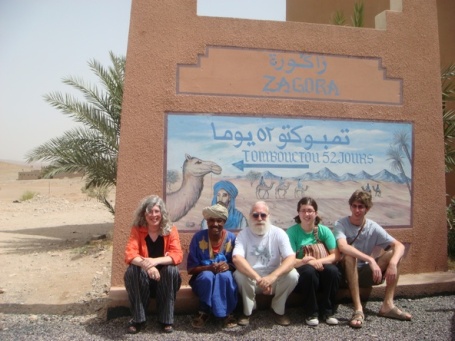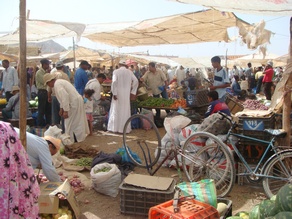Zagora
July 13, 2007 at 2:36 pm Leave a comment
Zagora is hot. Russ looked it up online: at 6 pm, he said, it was 102, presumably in the shade. But there isn’t much shade.
This was the end of the line–or the beginning, depending on which way your caravan was headed. I remember reading that the Sahara was more like an ocean, encouraging, not forbidding, trade. People, merchandise, ideas, styles passed through the desert for centuries. The diversity of clothing style and skin pigment make the centuries of connection quite apparent. Like Timbuktu at the southern end, Zagora at the northern end became a center of Muslim learning.
We were there not only because it’s the northern end of the trans-Sahara route (a sign on the south side of town claims it is 52 days to Timbuktu–see above, with Ibrahim). William had spent a month in the town in 1995 and wanted to go back with the family. We arrived Saturday evening and immediately met Ibrahim, one of the men he had known 12 years earlier. Back then, William had asked where he could get a black shesh like the one tied on his head; Ibrahim immediately sold it to him.
Zagora has expanded enormously in the intervening decade. The city to the south of the gates has remained six blocks wide and a few long, but a huge amount of building has gone on north of the gates. And a large, apparently brand new regional army headquarters has been built between the town and the river.
Saturday evening, we went with everyone else to the river. Groups of young men walked and rode motorbikes along the road and the river. We saw a couple of older men doing their prayers by the water. Young women walked together, the variety of dress still surprising me. Western clothing was everywhere, shirts and trousers on both men and women. Both also wear jalabas, long gowns with hoods hanging down the back. Some women wear a very long piece of cloth that is tied so it looks incredibly graceful as they walk, functioning simultaneously as a skirt, shawl, and head covering. Women with bare shoulders walked and talked with women who covered their heads, as everywhere we’ve been so far. The European and American effort to class covered and uncovered women as two distinct groups seems quite far from the mark.
Ian writes to describe the market we found on Sunday morning in the center of Zagora. “The market was like something out of a movie scene-you know, the one where the main character is looking for something in the bustling middle eastern market. There were rows and rows of stalls selling all kinds of things, from garden implements to music to spices to ten foot poles and ladders to produce to buckets made out of old tires. Some of the stalls were covered with expanses of slanting burlap, but most of them were open to the sun, and the heat baked the entire scene. Even more interesting in some ways than the things being sold were the people there to buy them. You had an absolute throng of humanity there, with covered women wearing elaborate and beautiful wraps brushing past young men wearing US army surplus pants that were too short for them with Charlotte Hornets t-shirts. You had men wearing jalabas and turbans with big knives stuck in their belts, and other men with impressive beards that looked like they hadn’t seen a sharp edge in months. It was an absolutely incredible scene.” William bought one cassette tape he heard playing in the market.
The sun was overwhelming, and I had to quit before the others were quite ready. After a brief rest, we drove south to Tamegroute to see the library. I don’t know anyone who has worked in this library, but Lonely Planet makes it seem an incredible resource for medievalists, with a collection containing “illlustrated religious texts, dictionaries, astrological works”the oldest dating to the 13th century. The town was a religious center from the 11th century, and the zawiya (17th century) includes a mosque, a school, a tomb, and the library. We couldn’t get in–we waited until it was supposed to open at 3, then were told that the person who opens it was busy. We did see the school’s courtyard, then drove far enough south to see some dunes and collect some Sahara sand.
When we returned to town, William went in search of his friend Lasan, who had managed the establishment where he stayed for a month more than a decade ago. He found Lasan in great spirits–his Japanese wife had just had a baby girl in Japan (a bit early) and he would be leaving in a few days to join her and hold their first child. We all went to his new “camping” to meet him, an incredibly warm man with a huge smile and lots of energy. He insisted we stay for coffee, and told us about his new apartment he was finishing for people wanting to stay longer-term in the new establishment he owns south of town. (Looks like a great place to stay to do research in the nearby library.)
Leaving Zagora was a bit difficult. We had planned to drive to Taroudannt, but the small, walled town (street sizes to population about the same as Avignon during the summer festival) seemed just overwhelming after the small mountain and desert towns, so we kept driving all the way to the Atlantic. William got to show the kids how to change a tire by the side of the road.
Taroudannt had been teeming and crazy busy on market day. Agadir was busy in an entirely different way. It is clearly a very successful tourist resort city. We heard very little Arabic, and walking along the waterfront (which one couldn’t get to because of the huge hotels) we saw an English pub, a taco restaurant, an invitation to supersize one’s meal, many boutiques. The new Agadir seems a European resort more than a Moroccan city. It does have a constant reminder of its past, though, in the huge mound that reads in Arabic “God, Country, King” slightly to the north of town. The 1960 earthquake did such extensive damage that people moved the city instead of trying to reconstruct it.
Entry filed under: Berbers, History, Middle East, Morocco, Travel.





Trackback this post | Subscribe to the comments via RSS Feed